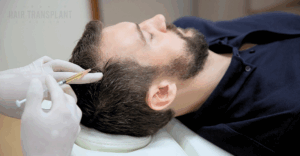Hair cloning is a new science-led advancement which may become the future of hair restoration. If this innovative approach is successful, it will undoubtedly become a beacon of hope for those battling hair loss. Many experts now consider hair cloning the ultimate solution for hair loss, as it has the potential to permanently resolve the issue for many individuals.
Distinct from traditional methods, hair cloning involves replicating hair follicles to create additional new, healthy ones. As we advance into 2024, hair cloning is not just a concept but a burgeoning reality, offering a glimpse into a future where hair loss could be reversed with an endless supply of hair follicles—potentially providing an unlimited hair supply for those in need.
Introduction to Hair Restoration
Hair restoration is a rapidly evolving field dedicated to addressing hair loss and helping individuals regain a full head of healthy hair. This area of medicine includes a variety of treatments, such as traditional hair transplants, innovative hair multiplication techniques, and the emerging science of hair cloning. The primary goal of hair restoration is to stimulate new hair growth and restore confidence by producing natural-looking results.
At the heart of all hair restoration treatments are hair follicles—the tiny structures within the scalp responsible for generating hair. Understanding hair follicle biology is crucial, as it allows researchers and clinicians to develop more effective ways to treat hair loss and encourage the growth of new hair. Whether through surgical procedures or advanced cellular therapies, the focus remains on creating healthy hair and achieving lasting, natural results for patients seeking to restore their hair.
Understanding Hair Growth
The process of hair growth is a remarkable interplay between several specialized cell types within the hair follicle. At the base of each follicle, dermal papilla cells act as key regulators, sending signals that control the growth and cycling of hair. Stem cells, located in the bulge region of the follicle, possess the unique ability to transform into various hair follicle cells, ensuring the regeneration and repair of the follicle itself. Keratinocytes, which make up the bulk of the hair shaft, are responsible for producing keratin—the protein that gives hair its strength and structure.
Hair growth occurs in a repeating cycle with three distinct phases. The anagen phase is the active growth period, during which the hair shaft is produced and lengthens. This is followed by the catagen phase, a brief period of regression when growth slows and the follicle shrinks. Finally, the telogen phase is a resting stage before the cycle begins anew. The coordinated activity of dermal papilla cells, stem cells, and keratinocytes ensures that hair continues to grow, shed, and regenerate throughout a person’s life, provided the follicles remain healthy and functional.
The Difference Between Hair Cloning and Hair Multiplication
While often used interchangeably, hair cloning and hair multiplication are distinct processes. Traditional methods like FUE and FUT involve extracting and transplanting existing hair follicles, and hair transplant is currently the standard, permanent solution for hair restoration, especially for those with enough donor hair. However, hair transplant cloning represents a future advancement, aiming to create new hair follicles in the lab to address severe baldness and overcome the limitations of current techniques. Hair cloning involves extracting cells from the hair follicle, replicating them in a lab, and reimplanting them to grow new hair. On the other hand, hair multiplication, or follicle cloning, takes a piece of the existing follicle and encourages it to regenerate, ideally leading to multiple hairs from a single follicle.
The Process: Understanding the Nuances
The process begins with the extraction or harvesting of specific cells from healthy hair follicles, which are then prepared for multiplication. Hair cloning, or hair follicle cloning, is more complex. It demands meticulous cell replication, ensuring the new cells maintain their ability to grow hair once implanted. Conversely, hair multiplication banks on the body’s natural ability to heal and regenerate, using existing follicle parts as a template.
Effectiveness and Outcomes: What to Expect
The efficacy of these methods varies. Hair cloning promises a potentially limitless supply of hair, assuming the cloned cells function as intended. The ultimate goal of these advanced techniques is to achieve permanent hair and provide new permanent hair in areas affected by hair loss, offering a long-lasting and reliable solution. Hair multiplication’s success hinges on the regenerative capacity of the existing follicles and may yield varied results.
The Idea Behind Hair Cloning
Hair cloning is born from a desire to overcome the limitations of current hair loss treatments. Traditional methods, like transplants, are restricted by the availability of healthy hair follicles. These methods depend on the donor area, donor hair, and donor hair follicles, which are often limited and can constrain the success of hair restoration procedures. Hair cloning aims to bypass this limitation by offering the potential to create an endless supply of hair follicles.
The Science Behind Hair Cloning
Hair cloning’s foundation lies in cell biology. Scientists isolate specific cells from a hair follicle, typically dermal papilla cells, known for their role in hair growth. These cells are then cultured in a lab, encouraged to multiply, and later implanted into balding areas. In the same way that cloning a whole organism like Dolly the Sheep involves replicating complex biological structures, cloning individual hair follicles presents unique challenges. Germ cells also play a critical role in the regeneration process, as they are essential for reproducing or stimulating hair follicle cells.
The challenge lies in maintaining their hair-growing ability post-cultivation due to the complex nature of hair follicle biology. To be effective, it is necessary to generate a large quantity of viable cells for implantation. Despite advancements, replicating the intricate regulatory mechanisms remains difficult.
Researchers aim to optimize cell culture techniques and better understand follicle biology to enhance cultured cells’ viability and functionality. The ultimate goal is to create fully functional hair follicles and generate new hair follicles for effective treatment. Success could revolutionize hair restoration, offering hope to millions affected by hair loss worldwide by growing hair and the ability to stimulate hair growth.
Principle Cell Types
Two critical cell types are leading the research on hair cloning – dermal papilla cells and keratinocytes. Dermal papilla cells are located at the bottom of hair follicles and control hair growth. On the other hand, keratinocytes are necessary in constructing the hair shaft. Dermal sheath cells are another important cell type in hair follicle bioengineering, contributing to the development of functional hair follicles.
Tissue engineering is playing a key role in developing new approaches for hair follicle regeneration.
Dermal Papilla Cells: The Growth Stimulators
Dermal papilla cells, located at the base of hair follicles, are key regulators of hair growth. Their primary function involves orchestrating the hair growth cycle by communicating with surrounding cells, particularly keratinocytes. Through intricate signaling mechanisms, dermal papilla cells stimulate the proliferation and differentiation of keratinocytes, essential for the formation of the hair shaft. In addition to their role in hair growth, dermal papilla cells contribute to wound repair and tissue regeneration by supporting the restoration of skin structure after injury.
Keratinocytes: The Building Blocks
Keratinocytes, vital components of the skin’s epidermis, play a crucial role in hair shaft formation. The skin, particularly human skin, serves as a critical microenvironment that supports hair follicle development by providing essential signals and extracellular matrix components. These specialized cells synthesize keratin proteins, which provide structural support to the hair. In hair cloning, integrating keratinocytes into the process is essential for producing functional hair strands with the appropriate structural integrity.
The Synergy: A Coordinated Effort
The success of hair cloning relies on the harmonious interaction between dermal papilla cells and keratinocytes. This coordinated effort ensures the proper formation and growth of each hair strand. The synergy between these cells is crucial for achieving the desired body of hair and promoting overall hair health. By replicating the synergistic relationship between these cell types, researchers strive to develop innovative treatments for various forms of hair loss, offering hope to millions worldwide.
How Soon Will Hair Cloning Come to Reality?
As of 2024, hair cloning is transitioning from theory to practice. Clinical trials and research are underway, but a definitive timeline for widespread availability remains uncertain. Regenerative medicine is playing a crucial role in advancing hair cloning by enabling innovative tissue engineering and cell-based therapies.
Given the current pace of scientific advancement, widespread hair cloning could be a reality within the next few years, potentially revolutionizing hair loss treatments. This progress promises significant benefits for the patient, as using the patient’s own cells in personalized regenerative therapies can reduce immune rejection and improve outcomes.
Possible Concerns
While promising, hair cloning raises concerns. Ethical questions about genetic manipulation and safety worries about potential side effects or long-term health impacts are paramount. However, advanced hair cloning techniques are being developed to ensure minimal damage to existing hair and scalp tissue, offering a more precise and minimally invasive approach. Regulatory bodies will play a vital role in addressing these concerns.
Ethical Questions on Genetic Manipulation:
The ethical implications of manipulating genetic material for cosmetic purposes raises fundamental questions about the boundaries of scientific intervention.
Safety Worries and Long-term Health Impacts:
The safety profile of hair cloning treatments prompts concerns regarding potential side effects and unforeseen health issues in the long term, underscoring the importance of comprehensive evaluation and monitoring.
Accessibility and Affordability:
The accessibility of hair cloning therapies remains uncertain, with concerns about whether these treatments will be accessible to the broader population or confined to a privileged few due to prohibitive costs.
Regulatory Oversight:
Regulatory bodies face the challenge of navigating the complex landscape of hair cloning technologies balancing innovation with public health and safety protection through robust regulatory frameworks.
Clinical Trials: Where Are We Now?
The journey toward effective hair cloning and hair multiplication treatments is well underway, with numerous clinical trials currently in progress. Leading research groups and companies are exploring ways to harness the regenerative power of hair follicles and their cells to stimulate new hair growth. For instance, the Aderans Research Institute has made significant strides, conducting phase 2 clinical trials on a cell therapy system designed to rejuvenate shrinking follicles and promote robust, long-lasting hair growth.
While early results from these trials are promising, several challenges remain. Researchers are working to ensure that cultured cells retain their ability to produce healthy hair and that the treatments are both safe and effective for patients. Ongoing research is focused on refining these techniques, optimizing cell culture conditions, and addressing any potential risks. As clinical trials progress, the hope is that hair cloning and multiplication will soon become viable options for those seeking to treat hair loss and restore their hair.
Risks With the Treatment
Like any new medical procedure, hair cloning carries risks. Unforeseen reactions to the cloned cells, issues with hair growth direction, and the potential for tumor development are serious considerations. Treating human hair loss—including male pattern baldness, thinning areas, and bald scalps—presents significant challenges for new technologies, as these conditions require effective, safe, and scalable solutions.
Patients must approach hair cloning with realistic expectations. It’s a promising field, but not without its potential pitfalls. Ongoing research is crucial to mitigate these risks.
Cost and Availability
As hair cloning and hair multiplication technologies are still in the early stages of development, the exact cost and availability of these treatments remain uncertain. It is anticipated that, at least initially, these advanced procedures will be more expensive than traditional hair transplants due to the complexity of the techniques and the cutting-edge research involved. However, as the technology matures and becomes more widely adopted, costs are expected to decrease, making these treatments more accessible to a broader range of patients.
For individuals struggling with significant hair loss, the promise of a permanent solution through hair cloning or multiplication is highly appealing. Nevertheless, it is important for patients to be aware of the potential risks, limitations, and the evolving nature of these treatments. Consulting with a qualified healthcare professional is essential to determine the most appropriate approach for each individual’s needs and to stay informed about the latest advancements in hair restoration.
Conclusion
Hair cloning stands at the forefront of a new era in hair restoration. As we venture into 2024, its possibilities are exciting and daunting. This guide has explored the intricacies of hair cloning, from its scientific underpinnings to the ethical and practical considerations.
As with any frontier in medicine, it carries both hope and responsibility. The journey from a concept to a cure is complex, but the potential to change lives is undeniable. Hair cloning could well be the next big leap in combating hair loss, offering a beacon of hope for millions worldwide.





